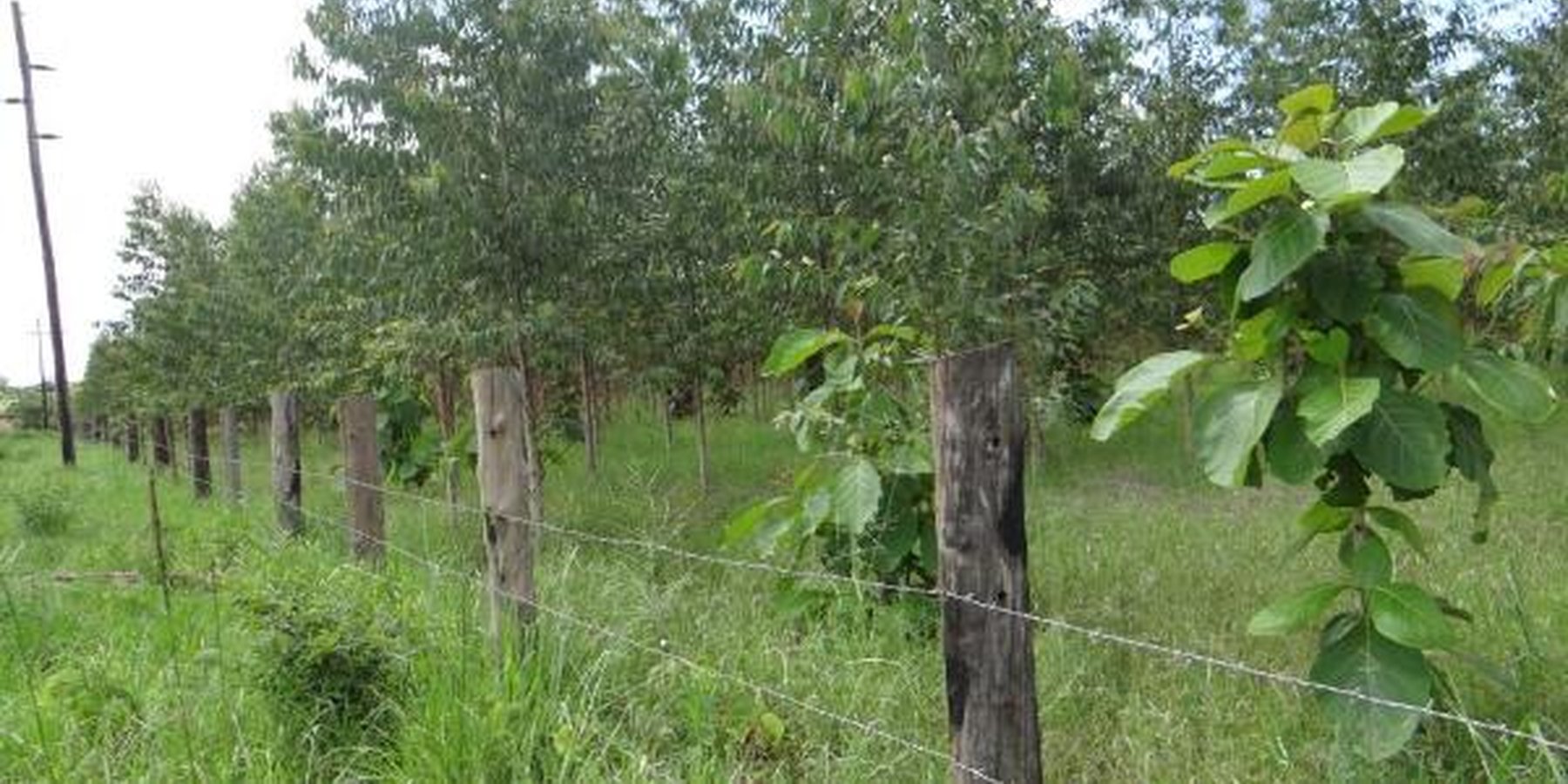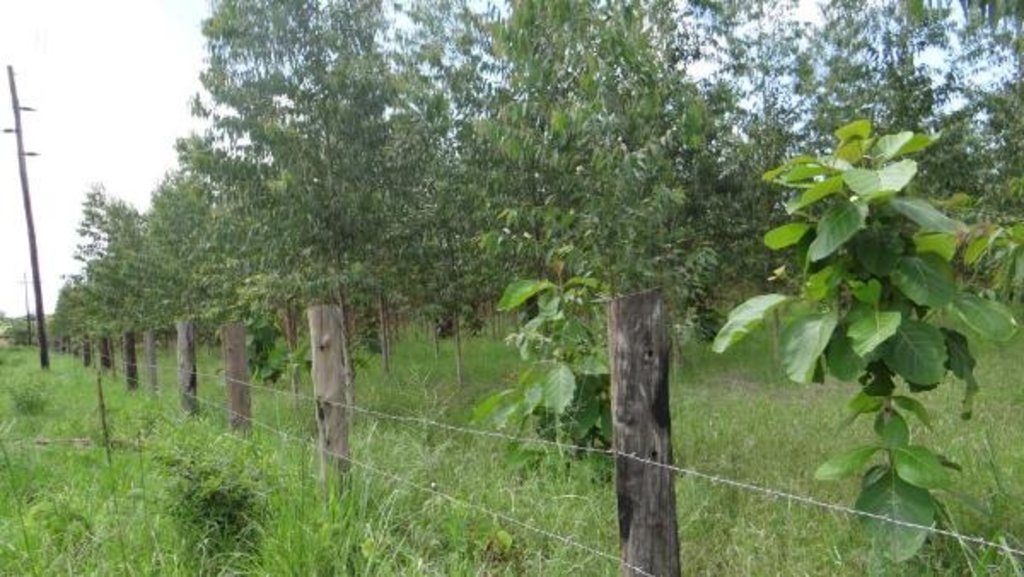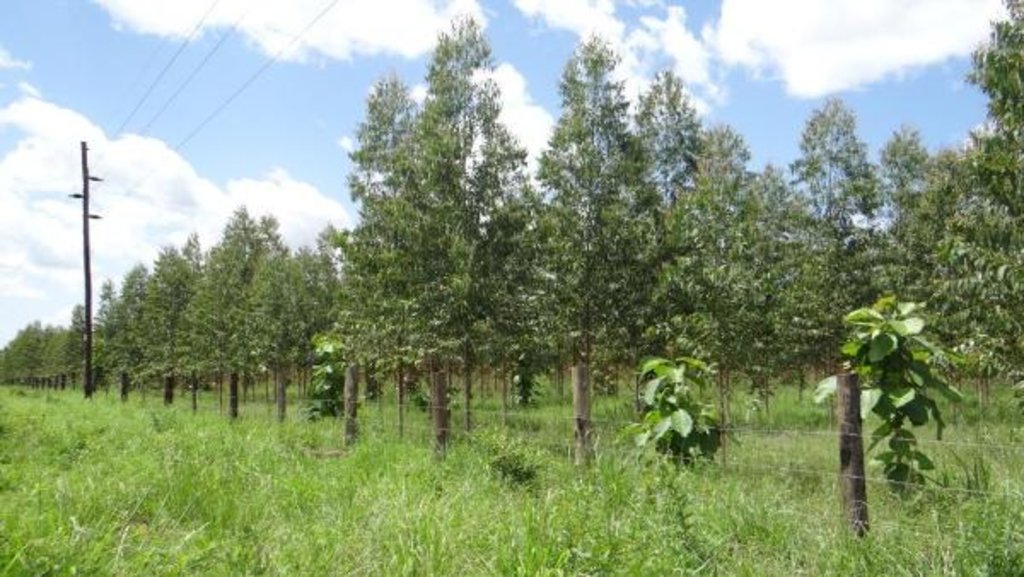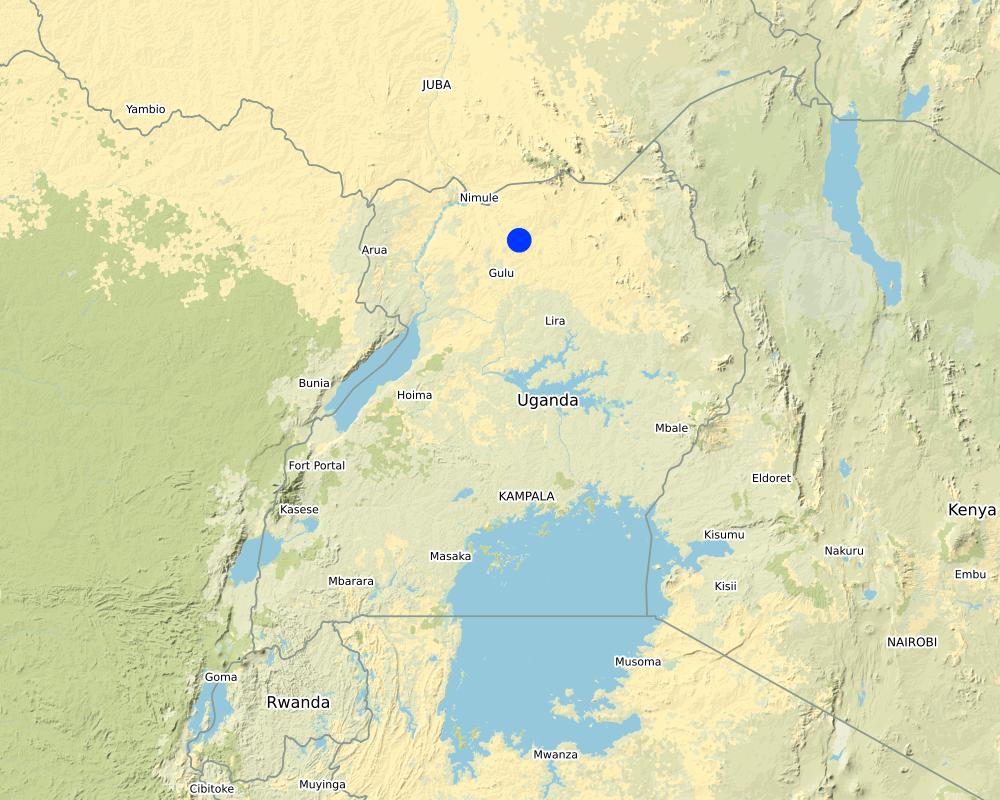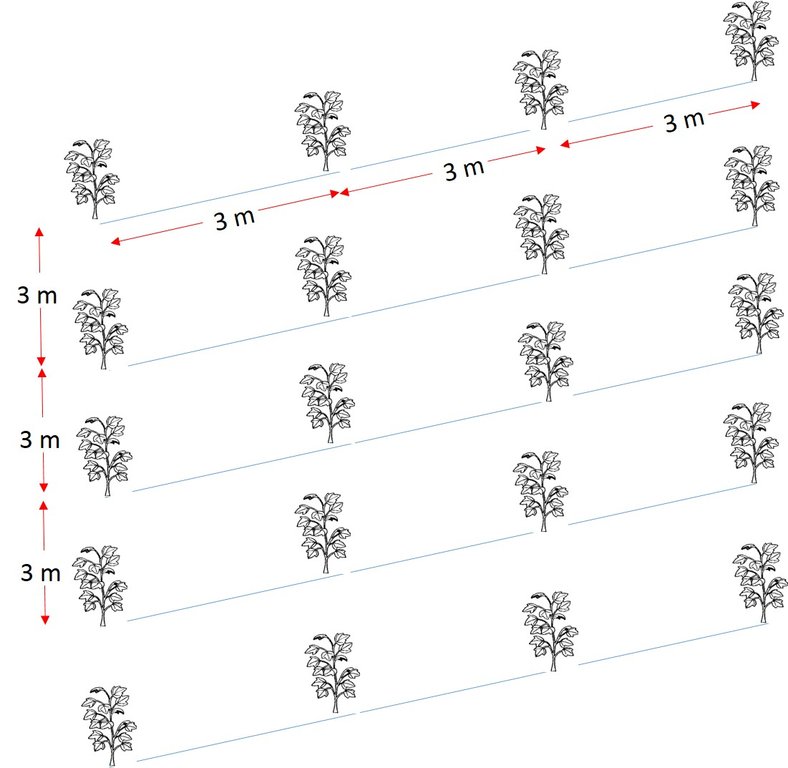Fast-Growing Clonal Eucalyptus [乌干达]
- 创建:
- 更新:
- 编制者: Bernard Fungo
- 编辑者: JOY TUKAHIRWA, Kamugisha Rick Nelson, betty adoch, Sunday Balla Amale
- 审查者: Drake Mubiru, Nicole Harari, Stephanie Jaquet, Udo Höggel
Pito yen Kalituc
technologies_2870 - 乌干达
查看章节
全部展开 全部收起1. 一般信息
1.2 参与该技术评估和文件编制的资源人员和机构的联系方式
关键资源人
土地使用者:
Anywar Francis
+256392962859 / +256753352572
anywarfrancis@gmail.com
Gene Ber Farmer
Lukole village, Olung parish, Agago District
乌干达
有助于对技术进行记录/评估的项目名称(如相关)
Scaling-up SLM practices by smallholder farmers (IFAD)有助于对技术进行记录/评估的机构名称(如相关)
Bern University of Applied Sciences, School of Agricultural, Forest and Food Sciences (HAFL) - 瑞士1.3 关于使用通过WOCAT记录的数据的条件
(现场)数据是什么时候汇编的?:
11/05/2017
编制者和关键资源人员接受有关使用通过WOCAT记录数据的条件。:
是
1.4 所述技术的可持续性声明
这里所描述的技术在土地退化方面是否存在问题,导致无法被认为是一种可持续的土地管理技术?:
否
2. SLM技术的说明
2.1 技术简介
技术定义:
Clonal eucalyptus trees (originating from South Africa) grow in northern Uganda for timber production
2.2 技术的详细说明
说明:
Clonal eucalyptus, commonly known as a hybrid of eucalyptus species developed by crossing various species of eucalyptus. It is fast-growing, attaining maturity for timber between 12 to15 years.
Seedlings for the eucalyptus clones are sold by various tree nursery operators in the area from where the farmers buy them. In preparation for tree planting, the land is cleared of all vegetation usually by slashing, but use of herbicides is also possible. Planting holes, measuring 30cm in diameter and depth, are dug at a spacing of 3m x 3m. Seedlings of 1-2 months age, bought from nurseries are planted in the prepared holes. Weeding is done twice a year for the first two years during which maize and beans can be intercropped with the young trees. Intercropping young trees with crops, a practice known as 'Taungya', helps to compensate for the weeding costs. Eucalyptus trees are generally self-pruning but if need arises, branches that have grown larger than 6 cm in diameter are removed using a saw. Pruning becomes necessary at the age of 3 years. At planting, the number of plants is 1,100 per hectare. Thinning is usually done at the age of 4 and 7 years, leaving about 450 plants per hactare. Protecting from animals and fire and is also done periodically by patrolling and creating fire lines in the plantation. The fire lines are created by dividing the plantation into smaller units and clearing 6-m wide strips between the units.
Farmers like the eucalyptus clones for establishing timber plantations because they grow fast and yield timber 5 to 7 years earlier than the non-hybrid species thus reducing the payback period for eucalyptus plantations. They are a source of income through the sale of poles and help in carbon sequestration which reduces the effect of climate change.
Farmers are apprehensive of this technology because the appropriate clones are difficult to locate in the tree nurseries. Secondly, some nursery operators do not tell the truth about the performance of different clones in the area. In northern Uganda, the most adaptable clone is 'GC 784', which has been observed to perform exceptionally well. The cost of the hybrid clones is 40% higher than the conventional seedlings.
2.3 技术照片
2.4 技术视频
日期:
10/5/2017
位置:
Agago District
2.5 已应用该技术的、本评估所涵盖的国家/地区/地点
国家:
乌干达
区域/州/省:
Northern
Map
×2.6 实施日期
注明实施年份:
2015
2.7 技术介绍
详细说明该技术是如何引入的:
- 通过土地使用者的创新
3. SLM技术的分类
3.1 该技术的主要目的
- 降低灾害风险
- 创造有益的经济影响
3.2 应用该技术的当前土地利用类型

农田
- 一年一作
主要农作物(经济作物及粮食作物):
Millet, Maize, Beans
3.3 有关土地利用的更多信息
该技术所应用土地的供水:
- 雨养
每年的生长季节数:
- 2
具体说明:
March-June and September-December
3.4 该技术所属的SLM组
- 森林种植管理
3.5 技术传播
具体说明该技术的分布:
- 均匀地分布在一个区域
如果该技术均匀地分布在一个区域上,请注明覆盖的大致区域。:
- < 0.1 平方千米(10 公顷)
3.6 包含该技术的可持续土地管理措施

植物措施
- V3:植被的清理
- V4:更换或清除外来/入侵物种

管理措施
- M3:根据自然和人文环境进行布局
3.7 该技术强调的主要土地退化类型

生物性退化
- Bc:植被覆盖的减少
3.8 防止、减少或恢复土地退化
具体数量名该技术与土地退化有关的目标:
- 防止土地退化
- 适应土地退化
4. 技术规范、实施活动、投入和成本
4.1 该技术的技术图纸
4.2 技术规范/技术图纸说明
Spacing of 3 x 3 meters between and within rows
Panting density of 1100 tree per ha
Thinning to 450 tree per ha around year 7
4.3 有关投入和成本计算的一般信息
具体说明成本和投入是如何计算的:
- 每个技术单元
指定单位:
Hectares
其它/国家货币(具体说明):
Uganda Shillings
注明美元与当地货币的汇率(如相关):1美元=:
3500.0
注明雇用劳工的每日平均工资成本:
10,000
4.4 技术建立活动
| 活动 | 措施类型 | 时间 | |
|---|---|---|---|
| 1. | Land clearing | 管理 | |
| 2. | Liming-out and pitting | 管理 | |
| 3. | Planting | 农业学的 | |
| 4. | Weeding | 管理 | |
| 5. | Thinning | 管理 |
4.5 技术建立所需要的费用和投入
| 对投入进行具体说明 | 单位 | 数量 | 单位成本 | 每项投入的总成本 | 土地使用者承担的成本% | |
|---|---|---|---|---|---|---|
| 劳动力 | Land cleaing | Hactares | 40.0 | 200003.0 | 8000120.0 | 100.0 |
| 劳动力 | Lining-out and pitting | Hactares | 40.0 | 200000.0 | 8000000.0 | 100.0 |
| 劳动力 | Planting | Hactares | 40.0 | 200000.0 | 8000000.0 | 100.0 |
| 劳动力 | Weeding | Hactares | 40.0 | 200000.0 | 8000000.0 | 100.0 |
| 设备 | Thinning | Hactares | 40.0 | 400000.0 | 16000000.0 | 100.0 |
| 植物材料 | Seedlings | Number | 1100.0 | 500.0 | 550000.0 | 100.0 |
| 技术建立所需总成本 | 48550120.0 | |||||
4.6 维护/经常性活动
| 活动 | 措施类型 | 时间/频率 | |
|---|---|---|---|
| 1. | Periodic Patrols | 管理 | Monthly |
4.7 维护/经常性活动所需要的费用和投入(每年)
| 对投入进行具体说明 | 单位 | 数量 | 单位成本 | 每项投入的总成本 | 土地使用者承担的成本% | |
|---|---|---|---|---|---|---|
| 劳动力 | Patrols | Years | 10.0 | 500000.0 | 5000000.0 | 100.0 |
| 技术维护所需总成本 | 5000000.0 | |||||
4.8 影响成本的最重要因素
描述影响成本的最决定性因素:
Buying seedlings
5. 自然和人文环境
5.1 气候
年降雨量
- < 250毫米
- 251-500毫米
- 501-750毫米
- 751-1,000毫米
- 1,001-1,500毫米
- 1,501-2,000毫米
- 2,001-3,000毫米
- 3,001-4,000毫米
- > 4,000毫米
农业气候带
- 半湿润
5.2 地形
平均坡度:
- 水平(0-2%)
- 缓降(3-5%)
- 平缓(6-10%)
- 滚坡(11-15%)
- 崎岖(16-30%)
- 陡峭(31-60%)
- 非常陡峭(>60%)
地形:
- 高原/平原
- 山脊
- 山坡
- 山地斜坡
- 麓坡
- 谷底
垂直分布带:
- 0-100 m a.s.l.
- 101-500 m a.s.l.
- 501-1,000 m a.s.l.
- 1,001-1,500 m a.s.l.
- 1,501-2,000 m a.s.l.
- 2,001-2,500 m a.s.l.
- 2,501-3,000 m a.s.l.
- 3,001-4,000 m a.s.l.
- > 4,000 m a.s.l.
说明该技术是否专门应用于:
- 不相关
5.3 土壤
平均土层深度:
- 非常浅(0-20厘米)
- 浅(21-50厘米)
- 中等深度(51-80厘米)
- 深(81-120厘米)
- 非常深(> 120厘米)
土壤质地(表土):
- 中粒(壤土、粉土)
土壤质地(地表以下> 20厘米):
- 中粒(壤土、粉土)
表土有机质:
- 中(1-3%)
5.4 水资源可用性和质量
地下水位表:
5-50米
地表水的可用性:
中等
水质(未处理):
仅供农业使用(灌溉)
水的盐度有问题吗?:
否
该区域正在发生洪水吗?:
否
5.5 生物多样性
物种多样性:
- 中等
栖息地多样性:
- 中等
5.6 应用该技术的土地使用者的特征
定栖或游牧:
- 定栖的
生产系统的市场定位:
- 商业/市场
非农收入:
- 收入的10-50%
相对财富水平:
- 平均水平
个人或集体:
- 个人/家庭
机械化水平:
- 手工作业
性别:
- 男人
土地使用者的年龄:
- 中年人
5.7 应用该技术的土地使用者拥有或租用的平均土地面积
- < 0.5 公顷
- 0.5-1 公顷
- 1-2 公顷
- 2-5公顷
- 5-15公顷
- 15-50公顷
- 50-100公顷
- 100-500公顷
- 500-1,000公顷
- 1,000-10,000公顷
- > 10,000公顷
这被认为是小规模、中规模还是大规模的(参照当地实际情况)?:
- 中等规模的
5.8 土地所有权、土地使用权和水使用权
土地所有权:
- 个人,未命名
土地使用权:
- 个人
用水权:
- 个人
5.9 进入服务和基础设施的通道
健康:
- 贫瘠
- 适度的
- 好
教育:
- 贫瘠
- 适度的
- 好
技术援助:
- 贫瘠
- 适度的
- 好
就业(例如非农):
- 贫瘠
- 适度的
- 好
市场:
- 贫瘠
- 适度的
- 好
能源:
- 贫瘠
- 适度的
- 好
道路和交通:
- 贫瘠
- 适度的
- 好
饮用水和卫生设施:
- 贫瘠
- 适度的
- 好
金融服务:
- 贫瘠
- 适度的
- 好
6. 影响和结论性说明
6.1 该技术的现场影响
社会经济效应
生产
木材生产
能源生产
生态影响
生物多样性:植被、动物
植被覆盖
生物量/地上C
6.2 该技术的场外影响已经显现
风力搬运沉积物
6.3 技术对渐变气候以及与气候相关的极端情况/灾害的暴露和敏感性(土地使用者认为的极端情况/灾害)
气候有关的极端情况(灾害)
气候灾害
| 该技术是如何应对的? | |
|---|---|
| 热浪 | 好 |
6.4 成本效益分析
技术收益与技术建立成本相比如何(从土地使用者的角度看)?
短期回报:
稍微积极
长期回报:
非常积极
技术收益与技术维护成本/经常性成本相比如何(从土地使用者的角度看)?
短期回报:
积极
长期回报:
非常积极
6.5 技术采用
- 1-10%
在所有采用这项技术的人当中,有多少人是自发地采用该技术,即未获得任何物质奖励/付款?:
- 90-100%
6.6 适应
最近是否对该技术进行了修改以适应不断变化的条件?:
否
6.7 该技术的优点/长处/机会
| 土地使用者眼中的长处/优势/机会 |
|---|
| Income |
| Timber |
| 编制者或其他关键资源人员认为的长处/优势/机会 |
|---|
| Eucalyptus clones have a shorter pay-back period compared to native species |
6.8 技术的弱点/缺点/风险及其克服方法
| 土地使用者认为的弱点/缺点/风险 | 如何克服它们? |
|---|---|
| The timber from eucalyptus clones has yet to be adequately tested for strength | Research |
| Risk of fire is very high in the area. Clones are highly susceptible. | Ensure the plantation is protected from fire by use of fire lines and frequent patrols |
| 编制者或其他关键资源人员认为的弱点/缺点/风险 | 如何克服它们? |
|---|---|
| Establishment cost | |
| Weeding |
7. 参考和链接
7.1 信息的方法/来源
- 实地考察、实地调查
1
- 与土地使用者的访谈
1
- 与SLM专业人员/专家的访谈
2
7.2 参考可用出版物
标题、作者、年份、ISBN:
N/a
7.3 链接到网络上可用的相关信息
标题/说明:
N/a
链接和模块
全部展开 全部收起链接
无链接
模块
无模块


